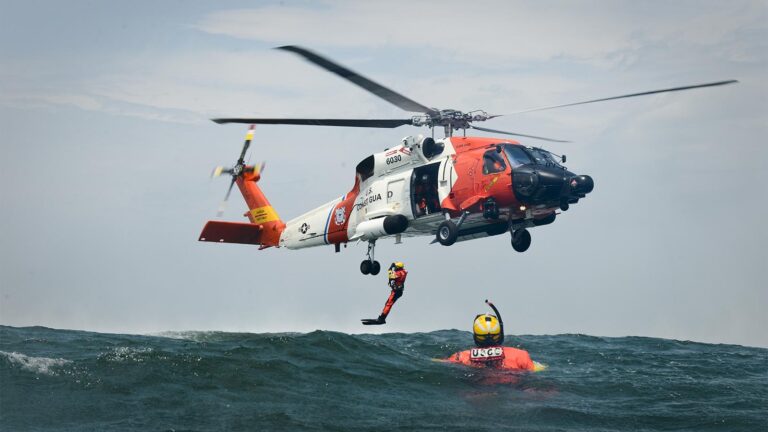In a coordinated rescue operation off the coast of San Diego, the United States Coast Guard and Navy successfully saved 18 individuals stranded on a disabled vessel. The joint effort highlights the readiness and collaboration of maritime forces in responding to emergencies at sea, ensuring the safety of those in distress along the busy Pacific coastline. Details of the incident and the rescue mission underscore the vital role these services play in safeguarding lives on the water.
Coast Guard and Navy Collaborate in Critical Rescue Operation Near San Diego
In a swift display of maritime coordination, the United States Coast Guard teamed up with the Navy to conduct a high-stakes rescue mission after a vessel experienced mechanical failure approximately 15 miles off the coast of San Diego. The disabled boat, carrying a total of 18 individuals, was reported drifting dangerously close to rocky waters amid strong currents and gusty winds. Responders promptly initiated a multi-agency operation involving surface vessels and helicopters to ensure the safety of all onboard.
The operation’s success hinged on effective communication and resource sharing between both services, highlighting their readiness for joint emergency response. Key elements of the rescue included:
- Deployment of MH-60 Jayhawk helicopters for aerial reconnaissance and personnel extraction
- Utilization of fast-response cutters to secure the vessel and provide medical assistance
- Coordination through the Maritime Rescue Coordination Center to optimize timing and logistics
| Rescue Asset | Role | Number Deployed |
|---|---|---|
| MH-60 Jayhawk Helicopters | Aerial Support & Extraction | 2 |
| Coast Guard Cutters | Surface Rescue & Medical Aid | 3 |
| Navy Support Boats | Secondary Rescue & Backup | 1 |
Challenges Faced During the Disabled Vessel Recovery Effort
The recovery operation presented multiple obstacles that tested the coordination and resilience of Coast Guard and Navy teams. One of the primary challenges was the unpredictable sea conditions, with waves reaching heights that complicated both the approach to the disabled vessel and the transfer of survivors. Additionally, the disabled boat’s unstable position increased the risk of capsizing during rescue attempts, requiring careful maneuvering to avoid further endangerment to both passengers and rescuers. Communication difficulties due to intermittent radio signals also hindered real-time coordination between vessels and air support.
The teams faced logistical hurdles including:
- Limited daylight hours, which pressured the need for a swift operation before nightfall.
- Fuel constraints, as nearby support ships had to manage resources efficiently to sustain extended search efforts.
- Medical emergencies on board, necessitating immediate triage and prioritization under challenging conditions.
| Challenge | Impact | Resolution Effort |
|---|---|---|
| Rough Seas | Risk of capsizing | Careful vessel approach and timing |
| Communication Gaps | Delayed coordination | Backup signal relays deployed |
| Medical Cases | Time-sensitive care needed | Onboard medics prioritized treatment |
Safety Protocols and Training Behind Successful Maritime Rescues
Every successful maritime rescue hinges on rigorous safety protocols meticulously designed to safeguard both the rescuers and those in distress. Prioritizing clear communication among Coast Guard and Navy teams, these protocols include pre-departure equipment checks, emergency medical readiness, and continuous situational awareness training. Crews operate under the principle that preparation is paramount—ensuring all members are familiar with rescue vessels, personal protective gear, and specialized tools required for disabled vessel operations.
Training exercises simulate a variety of emergency scenarios to build seamless coordination among responders. These drills reinforce key competencies in navigation under adverse conditions, casualty extraction, and swift medical triage. Key components emphasized during training include:
- Advanced Search and Rescue Techniques
- Helicopter Hoist Operations
- Emergency Medical Protocols
- Communication Drills with Multidisciplinary Teams
| Safety Element | Purpose |
|---|---|
| Personal Flotation Devices (PFDs) | Ensure rescuer buoyancy and reduce drowning risk |
| Rescue Basket Training | Efficient and safe extraction of individuals from water |
| Night Operations Drills | Maintain effectiveness under low-visibility conditions |
| First Aid & CPR | Immediate life-saving interventions on-scene |
Recommendations for Boaters to Prevent Similar Emergencies Off the Coast
Boaters venturing near the San Diego coast are urged to prioritize vessel maintenance and preparedness to avoid similar emergencies. Before setting sail, ensure all mechanical systems are thoroughly checked, and essential safety equipment such as life jackets, flares, and communication devices are on board and in working order. Staying updated on weather forecasts and sea conditions is vital; unexpected shifts can escalate risks rapidly. Additionally, filing a float plan with a trusted contact provides a critical safety net by alerting authorities if the vessel doesn’t return as scheduled.
In the event of any mechanical failure or distress, remain calm and signal for help promptly. Utilizing a marine VHF radio or emergency position-indicating radio beacon (EPIRB) can accelerate search and rescue efforts. It is also recommended to travel with a companion or in convoy when possible, enhancing mutual assistance capabilities. The Coast Guard advises all mariners to attend safety courses or briefings to familiarize themselves with emergency procedures and local navigational hazards.
Key Takeaways
The coordinated efforts of the United States Coast Guard and Navy underscore the critical importance of maritime safety and rapid response along the San Diego coast. Thanks to their swift action and expertise, all 18 individuals aboard the disabled vessel were safely rescued without injury. This incident serves as a reminder of the ongoing vigilance required to protect lives at sea and the vital role these agencies play in safeguarding the region’s waterways. Authorities continue to investigate the cause of the vessel’s mechanical failure as operations return to normal.







